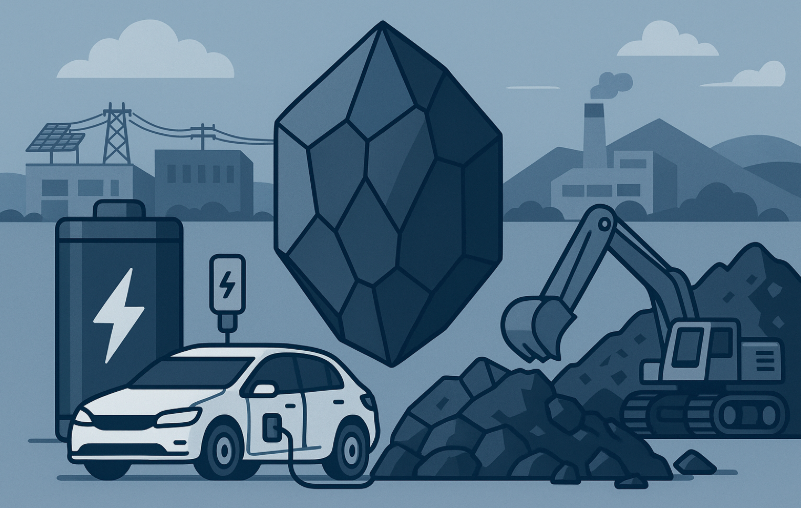Today, graphite is no longer simply a niche industrial mineral. With its role as the backbone of lithium-ion batteries and as a vital component in electric vehicles (EVs), energy storage systems, and emerging clean technologies, graphite has quietly grown to be one of the most important materials for the next generation of energy systems. According to Benchmark Mineral Intelligence, demand for natural graphite for batteries could grow five to eight times by 2035, with a potential supply gap as soon as 2027.
Why Graphite Matters
An electric vehicle requires a minimum of 50–100 kilograms of graphite in its battery anodes — far more than lithium, nickel, or cobalt in the same cell — according to data from Benchmark Mineral Intelligence, the World Bank, and the International Energy Agency (IEA). The production of synthetic graphite remains highly energy-intensive and dependent on petroleum coke, making natural graphite the more sustainable solution if produced responsibly. As nations accelerate energy transition goals, graphite has been added to the list of officially recognized critical minerals essential for national security and industrial independence.
The IEA notes that graphite could face one of the steepest supply gaps among all battery materials by 2035, with refined production lagging demand by around 25%. Benchmark data further shows that over 300 new graphite mines will be needed globally by 2035 to meet projected EV demand.

Forecast for the Global Market
The global graphite market is forecast to expand from about US$14–18 billion in 2025 to US$26–35 billion by 2035, representing a 5–6% CAGR. Natural graphite demand is anticipated to increase by 140% by 2030 to approximately 1.7 million tonnes per year. However, China currently dominates 78% of global graphite production and over 90% of anode processing capacity, according to the U.S. Geological Survey (USGS) and Benchmark Minerals Intelligence. This concentration creates major supply-chain vulnerabilities for Western economies.
The USGS also indicates that Western countries — including Canada and the U.S. — are prioritizing the diversification of graphite supply chains away from Chinese refining capacity. Benchmark Minerals data suggests that over US$7.5 billion in new capital investment will be required globally to meet battery-grade graphite demand by 2035.
Canada’s Critical Minerals Strategy
Canada is positioning itself as a global hub for graphite. Under its Critical Minerals Strategy, the federal government aims to develop end-to-end domestic supply chains for EV and battery materials — spanning exploration, processing, and recycling. Ontario and Québec are emerging as the twin engines of this national plan, given their geology and proximity to major automotive manufacturing centers.
According to Natural Resources Canada (NRCan), Canada hosts over 35 known graphite deposits, with Québec’s North Shore and Ontario’s Greenstone Belt offering the highest grades and scalability. In 2023, Canada produced approximately 4,261 tonnes of natural graphite, down from 13,597 tonnes in 2022, with all current production coming from the Lac des Îles Mine in Québec. Emerging projects such as Nouveau Monde Graphite (Québec) and Northern Graphite (Ontario) are advancing toward commercial production, bolstered by federal incentives for downstream anode manufacturing.

Ontario and Québec: The New Graphite Frontier
Ontario’s Geraldton–Beardmore Greenstone Belt and Québec’s Abitibi region have reemerged as key exploration hotspots. Ontario alone invested about C$976 million in exploration and deposit appraisal in 2023 — nearly 23% of Canada’s total — while Québec’s exploration spending for critical and strategic minerals surged from CA$142 million in 2019 to CA$477 million in 2024, an increase of roughly 235%. Both provinces feature robust infrastructure, experienced labor, and mining-friendly permitting frameworks.
Ontario’s 2025 geological report projects a 28% year-over-year increase in active graphite claims and more than C$50 million in new government funding for early-stage exploration grants, illustrating the province’s commitment to developing its graphite industry. In Québec, Nouveau Monde Graphite’s Bécancour plant represents over C$1 billion in planned capital expenditures, while Northern Graphite is advancing multi-million-dollar projects across the province — positioning Québec as a cornerstone of Canada’s battery supply chain.
Golden Rapture Mining: Strategic Expansion from Gold to Critical Minerals
Golden Rapture Mining (CSE: GLDR) — a growing exploration company with projects in Ontario — is well-positioned to capitalize on Canada’s graphite momentum. Its Hutchison Mine Project, located near Equinox Gold’s Greenstone Mine, hosts gold, silver, zinc, and copper, as well as extensive graphite zones. Historical drilling by Noranda Mining in the 1980s revealed graphite intersections in nearly every hole, with grades ranging from 30% to 40%. These results position Hutchison as a dual-commodity asset capable of delivering both precious and critical minerals.
Golden Rapture’s portfolio also includes:
- Phillips Township Gold Project: 10,000 acres with 18 historical mine shafts, with recent assays up to 285.00 g/t Au.
- Bully Boy Mine Project: Adjacent to Rainy River, with grab samples up to 78.79 g/t Au.
By integrating graphite exploration alongside high-grade gold projects, Golden Rapture Mining exemplifies Canada’s broader strategy of linking traditional mining strengths with next-generation critical minerals development.

Investment Takeaways
- Graphite demand expected to grow 5–8x by 2035 (Benchmark Minerals, IEA)
- 300+ new graphite mines required globally by 2035 to meet EV battery demand
- Canada hosts 35+ graphite deposits; 2023 production ~4,261 tonnes (NRCan)
- China supplies 78% of global graphite and over 90% of anode processing (USGS)
- Golden Rapture Mining (CSE: GLDR) provides exposure to both gold and graphite through its Hutchison and Phillips Township projects
Conclusion
Graphite’s role in the clean energy transition is poised to mirror lithium’s rise over the past decade. With demand accelerating and Western nations seeking to localize supply chains, explorers like Golden Rapture Mining could be instrumental in establishing Canada’s graphite future — transforming historic gold camps into key assets for tomorrow’s global battery industry.
Marc has been involved in the Stock Market Media Industry for the last +5 years. After obtaining a college degree in engineering in France, he moved to Canada, where he created Money,eh?, a personal finance website.

